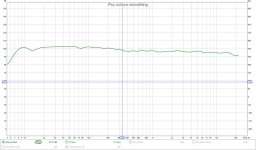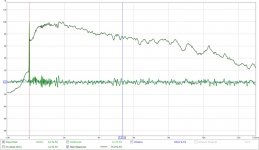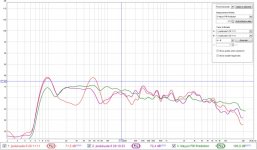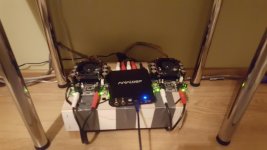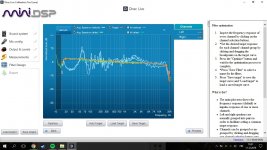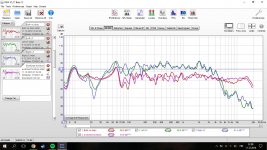It would make sense, yes. That's what Acourate does, correct separate drivers including their roll off, and after that correct the total result.
However, the Harsh crossover gets the result in the ballpark for a bit of FIR action to finish it off. But the diffraction part doesn't get fixed. it clearly eats away something slightly below 2 KHz.
You'll get more trouble getting depth in the songs if this happens in a stereo pair. It will be a bit flatter in perception at listening distance. The fix in phase around 100-200 Hz will be noticeable though, nice slam of the drums!
Here's the reason my FIR recipe doesn't fix the diffraction trouble. This is what REW's Psychoacoustic filter looks like on the FIR prediction :

IR and STEP:

Final room curve would be up for debate 😉.
One more to add, all 3 graphs in the same Psychoacoustic smoothing:

Now if there's room for the actual EQ edits remains to be seen. This FIR recipe is made for line arrays that can take up to 240 Watt before running out of steam. We'd have to check real boost values etc. Plus invest more time in measurements to see what happens off axis with correction like this in place.
However, the Harsh crossover gets the result in the ballpark for a bit of FIR action to finish it off. But the diffraction part doesn't get fixed. it clearly eats away something slightly below 2 KHz.
You'll get more trouble getting depth in the songs if this happens in a stereo pair. It will be a bit flatter in perception at listening distance. The fix in phase around 100-200 Hz will be noticeable though, nice slam of the drums!
Here's the reason my FIR recipe doesn't fix the diffraction trouble. This is what REW's Psychoacoustic filter looks like on the FIR prediction :
IR and STEP:
Final room curve would be up for debate 😉.
One more to add, all 3 graphs in the same Psychoacoustic smoothing:
Now if there's room for the actual EQ edits remains to be seen. This FIR recipe is made for line arrays that can take up to 240 Watt before running out of steam. We'd have to check real boost values etc. Plus invest more time in measurements to see what happens off axis with correction like this in place.
Attachments
Last edited:
Getting slopes including individual driver EQ right is seen before and have myself but is normal done at distances equal 1 meter or less, was looking forward to hear sound results with correct slopes executed before tonal balance at listening position.
Agree that slightly below 2kHz point problem is not welcome and will add to problems analyzed over Pano's thread, but have to say wow to post 162 visuals I like to buy that correction as a plug in 😀
Agree that slightly below 2kHz point problem is not welcome and will add to problems analyzed over Pano's thread, but have to say wow to post 162 visuals I like to buy that correction as a plug in 😀
We are having fun here, but where's Mayuri?
On a final note of the day: as the diffraction still fills in the dip at 2 KHz, it might not be as bad as we think. Tonality is gathered over a longer time period while that first clean wave front gives us more clear imaging. As 2 KHz usually is a problem area in a stereo setup by the speakers cross talk to the opposite ear, having some early reflections/diffraction to fill in the dip a little later in time might actually sound better than expected.
Still we're shooting in the dark without checking near off axis points to the listening spot. Nobody likes the head in vice listening position, do they?
Without knowing what the sound wave looks like off axis all I did is make pretty pictures. Maybe Dirac has a very good and valid reason as it's generated by measuring in more than one spot.
The way I checked this in my own case is correcting in the exact sweet spot and after that checking the average over a wide area of measurement spots. Usually the higher range stays pretty much similar, if diffraction isn't a big issue.
On a final note of the day: as the diffraction still fills in the dip at 2 KHz, it might not be as bad as we think. Tonality is gathered over a longer time period while that first clean wave front gives us more clear imaging. As 2 KHz usually is a problem area in a stereo setup by the speakers cross talk to the opposite ear, having some early reflections/diffraction to fill in the dip a little later in time might actually sound better than expected.
Still we're shooting in the dark without checking near off axis points to the listening spot. Nobody likes the head in vice listening position, do they?
Without knowing what the sound wave looks like off axis all I did is make pretty pictures. Maybe Dirac has a very good and valid reason as it's generated by measuring in more than one spot.
The way I checked this in my own case is correcting in the exact sweet spot and after that checking the average over a wide area of measurement spots. Usually the higher range stays pretty much similar, if diffraction isn't a big issue.
Last edited:
You are having fun in here whilst I am busy working 😀
Having a busy weekend, I'll get back to it on sunday. And in fact those measurements were done with both speakers running. I'll measure just left-right the next time I run them. I was running up to 2kHz because I was experimenting how different slopes sound, just had it running without high frequencies processed 🙂
Having a busy weekend, I'll get back to it on sunday. And in fact those measurements were done with both speakers running. I'll measure just left-right the next time I run them. I was running up to 2kHz because I was experimenting how different slopes sound, just had it running without high frequencies processed 🙂
Ah... I asked that question because of the dip I saw at high frequencies in your measurements. I figured it might be some cross talk between both channels though it wasn't (that) obvious by looking at the IR. I figured the 10F should do better on it's own.
The room effects aren't too bad. You should be able to make something out of it that sounds real nice...
The room effects aren't too bad. You should be able to make something out of it that sounds real nice...
My Sure amp modules finally came from China, so I upgraded my amplifier with SMPS 24V 10A brick and two Sure AA-AB32971 amplifiers. Noticed a drop in background noise, so they might actually be worth their price.
Anyhow, I'm not sure how to implement filters from REW to actually filter the signal. Tried the waterfall thing with the filter wesayso produced, but didn't really understand what I was seeing. Figured since I have a new amplifier, it might have some different in measurements, so I re-ran everything and then a bit more. Now there are multiple measurements from the listening spot with all kinds of combos and a bit of off-axis measurements from near- & farfield. The neighbors kids are being quite lively today, so there might be some artefacts from that in the measurements.
BYRTTs idea of finishing of perfecting the crossover, then having a go at further corrections first seems logical. How would I go about it?
Off-axis 60cm: https://www.dropbox.com/s/9lvkagzom4ntqz1/off-axis 60cm.zipdl=0 (dirac was off, 350Hz Harsch XO, 1,6ms delay on HF)
Off-axis from seat: https://www.dropbox.com/s/t0bck0vm4ku9fow/off-axis seat.zip?dl=0
Measurements from seat: https://www.dropbox.com/s/246gmrzt1gblmlh/spot at seat.zip?dl=0
By the way thank you two for all your help. I really appreciate it. Problem is, I have only a basic idea what to measure. With a lot of these, I have completely no idea what I'm doing and if they are going to be of any use.
Anyhow, I'm not sure how to implement filters from REW to actually filter the signal. Tried the waterfall thing with the filter wesayso produced, but didn't really understand what I was seeing. Figured since I have a new amplifier, it might have some different in measurements, so I re-ran everything and then a bit more. Now there are multiple measurements from the listening spot with all kinds of combos and a bit of off-axis measurements from near- & farfield. The neighbors kids are being quite lively today, so there might be some artefacts from that in the measurements.
BYRTTs idea of finishing of perfecting the crossover, then having a go at further corrections first seems logical. How would I go about it?
Off-axis 60cm: https://www.dropbox.com/s/9lvkagzom4ntqz1/off-axis 60cm.zipdl=0 (dirac was off, 350Hz Harsch XO, 1,6ms delay on HF)
Off-axis from seat: https://www.dropbox.com/s/t0bck0vm4ku9fow/off-axis seat.zip?dl=0
Measurements from seat: https://www.dropbox.com/s/246gmrzt1gblmlh/spot at seat.zip?dl=0
By the way thank you two for all your help. I really appreciate it. Problem is, I have only a basic idea what to measure. With a lot of these, I have completely no idea what I'm doing and if they are going to be of any use.
Attachments
Last edited:
I did not have the energy to take a look today, but... judging that graph you have to be aware of the boost you're giving that low end. It looks to be at least 7 dB of boost.
(said the one that has about 14 dB boost on his low end)
(said the one that has about 14 dB boost on his low end)
No worries, I'm having a hard time finding energy as well 😀 Worked till 4 am last night, my brains aren't quite working today. I know the LF boost is quite high, but overall my listening levels are low-ish (apartment building) and distortion/power handling shouldn't be a problem.I did not have the energy to take a look today, but... judging that graph you have to be aware of the boost you're giving that low end. It looks to be at least 7 dB of boost.
(said the one that has about 14 dB boost on his low end)
By the way, figured out how to implement the filters you posted to MiniDSP. Listening to them currently.
EDIT: Tried them both, and maybe liked the first one you posted more. The second one gave an impression of listening through a 10€ mini bluetooth speaker, it sounded somehow hollow. Both sounded a bit "hot" for me, but it simply be because the amplifiers / chair position / mindset changed 😀 But I got to admit they brought something to the sound it didn't have before. I'll post measurements shortly.
I originally intended on using the Volumio OS with Raspberry Pi for this project, but since it has been very unstable lately it seems I am stuck with my laptop as the music player. Since nowadays you can route other music sources through JRiver, (Spotify...) maybe I should give it a go with DRC? I'll still use the MiniDSP as crossover and delay maker though.
Last edited:
https://www.dropbox.com/s/h3qtrfmm3y8sock/wesayso filters.zip?dl=0

Here are the measurements (Dirac on with everything, tell me if you want if off). They are no filter, filter 1 and filter 2. It kinda shows that they were made for the previous set of measurements. Don't mind the top end, just experimenting with target curves.
EDIT: I wonder if it would help the HUGE null at 70Hz is I re-organized my room and flipped the place of speakers and listening chair. It's making the music sound a very anemic. Need to solve it somehow (maybe just pull my listening chair forward), and in this task DSP just isn't going to cut it.
Here are the measurements (Dirac on with everything, tell me if you want if off). They are no filter, filter 1 and filter 2. It kinda shows that they were made for the previous set of measurements. Don't mind the top end, just experimenting with target curves.
EDIT: I wonder if it would help the HUGE null at 70Hz is I re-organized my room and flipped the place of speakers and listening chair. It's making the music sound a very anemic. Need to solve it somehow (maybe just pull my listening chair forward), and in this task DSP just isn't going to cut it.
Attachments
Last edited:
Yes, those were for the previous measurements. The new red curve is better behaved on first sight.
Is that dip there in both channels? Left and right? I have a similar (though higher Q) dip in my left channel from my corner placement. I don't use boost there but instead bring it down some more. Then after boosting a little in the other channel I compensate.
They add to flat with both speakers playing. It's the best I could do.
The left channel is better at playing real low, so there the right one is a few dB's behind. The higher harmonics still make the positioning of percussion seem right in imaging.
You probably don't have that luxury, as the left and right speaker output was pretty symmetrical in the first measurements you showed.
Is that dip there in both channels? Left and right? I have a similar (though higher Q) dip in my left channel from my corner placement. I don't use boost there but instead bring it down some more. Then after boosting a little in the other channel I compensate.
They add to flat with both speakers playing. It's the best I could do.
The left channel is better at playing real low, so there the right one is a few dB's behind. The higher harmonics still make the positioning of percussion seem right in imaging.
You probably don't have that luxury, as the left and right speaker output was pretty symmetrical in the first measurements you showed.
Looks like switching furniture around didn't really help much. That 70Hz dip is inherent to this room. Shame, can't do much to help it. Will probably swap order back tomorrow unless there's some massive improvement that I missed, room feels much less spacey with the listening chair next to the door. Attentuating the output to be level with the 70Hz dip might work, I still should have plenty of headroom on my amps.
In the picture you can see the furniture swap test (bass trap, bookself, chair, loudspeakers) along with 3 measurements from old listening place. Here's the measurement file:
https://www.dropbox.com/s/szxy91fw6ibwg5r/switched furniture.mdat?dl=0
In the picture you can see the furniture swap test (bass trap, bookself, chair, loudspeakers) along with 3 measurements from old listening place. Here's the measurement file:
https://www.dropbox.com/s/szxy91fw6ibwg5r/switched furniture.mdat?dl=0
Attachments
Last edited:
Looks like switching furniture around didn't really help much. That 70Hz dip is inherent to this room. Shame, can't do much to help it. Will probably swap order back tomorrow unless there's some massive improvement that I missed, room feels much less spacey with the listening chair next to the door. Attentuating the output to be level with the 70Hz dip might work, I still should have plenty of headroom on my amps.
In the picture you can see the furniture swap test (bass trap, bookself, chair, loudspeakers) along with 3 measurements from old listening place. Here's the measurement file:
https://www.dropbox.com/s/szxy91fw6ibwg5r/switched furniture.mdat?dl=0
What happens if you remove just the bass trap and remeasure? Maybe it's sucking enough bass energy out to affect that 70Hz dip.
Do I get this right;
Left low end: not a trace of that dip
Right low end: not a trace of that dip
Both speakers running: dip is there? At least, the separate measurements don't show such a deep dip. If that would be the case, the timing between left and right would be to blame.
If I'm off base, you got to tell me what that left LF and right LF is.
Left low end: not a trace of that dip
Right low end: not a trace of that dip
Both speakers running: dip is there? At least, the separate measurements don't show such a deep dip. If that would be the case, the timing between left and right would be to blame.
If I'm off base, you got to tell me what that left LF and right LF is.
I'll try this tomorrow. I have couple big acoustic panels behind me at the moment as well, will dump everything out before remeasure.What happens if you remove just the bass trap and remeasure? Maybe it's sucking enough bass energy out to affect that 70Hz dip.
And wesayso, you are entirely correct. Somehow I missed that whilst I was measuring. I don't really understand how they could suck energy out of eachother unless they were out of phase. Really strange. Would alterning speaker-to-speaker distance change this?
Last edited:
I'll try this tomorrow. I have couple big acoustic panels behind me at the moment as well, will dump everything out before remeasure.
And wesayso, you are entirely correct. Somehow I missed that whilst I was measuring. I don't really understand how they could suck energy out of eachother unless they were out of phase. Really strange. Would alterning speaker-to-speaker distance change this?
As wesayso and others have stressed before, the room+speakers have to be treated as a system. Of course, WAF can affect your ability to effectively treat both parts of this equation. And we aren't even including your amp+source in this system consideration.
It will be interesting to see what tweaking the room treatments will do to your measurements.
I'll try this tomorrow. I have couple big acoustic panels behind me at the moment as well, will dump everything out before remeasure.
And wesayso, you are entirely correct. Somehow I missed that whilst I was measuring. I don't really understand how they could suck energy out of eachother unless they were out of phase. Really strange. Would alterning speaker-to-speaker distance change this?
Wavelength at 70Hz is 490cm so it could well be boundary interference (SBIR) causing the null. If your speakers are placed symmetrically in the room this could be making the boundary interference worse when both are playing together. Try to offset the gap between the speakers or move them further into the room to measure and see if there is any difference.
I'd play a tone at about 70Hz, doesn't have to be loud. Now, walk around your room from corner to corner. Do you hear the loudness changing as you walk, or does it stay the same?
Place the speakers 2m off the back wall. Walk again. Place them at 1.5m, then 1m then 500cm...... Feel how they interact with the room. Experiment. Get to know how the room behaves with your speakers. That will take some of the guessing away and start to narrow down the problem(s).
Place the speakers 2m off the back wall. Walk again. Place them at 1.5m, then 1m then 500cm...... Feel how they interact with the room. Experiment. Get to know how the room behaves with your speakers. That will take some of the guessing away and start to narrow down the problem(s).
- Status
- Not open for further replies.
- Home
- Loudspeakers
- Full Range
- Hi-End Full-Range project
 .
.